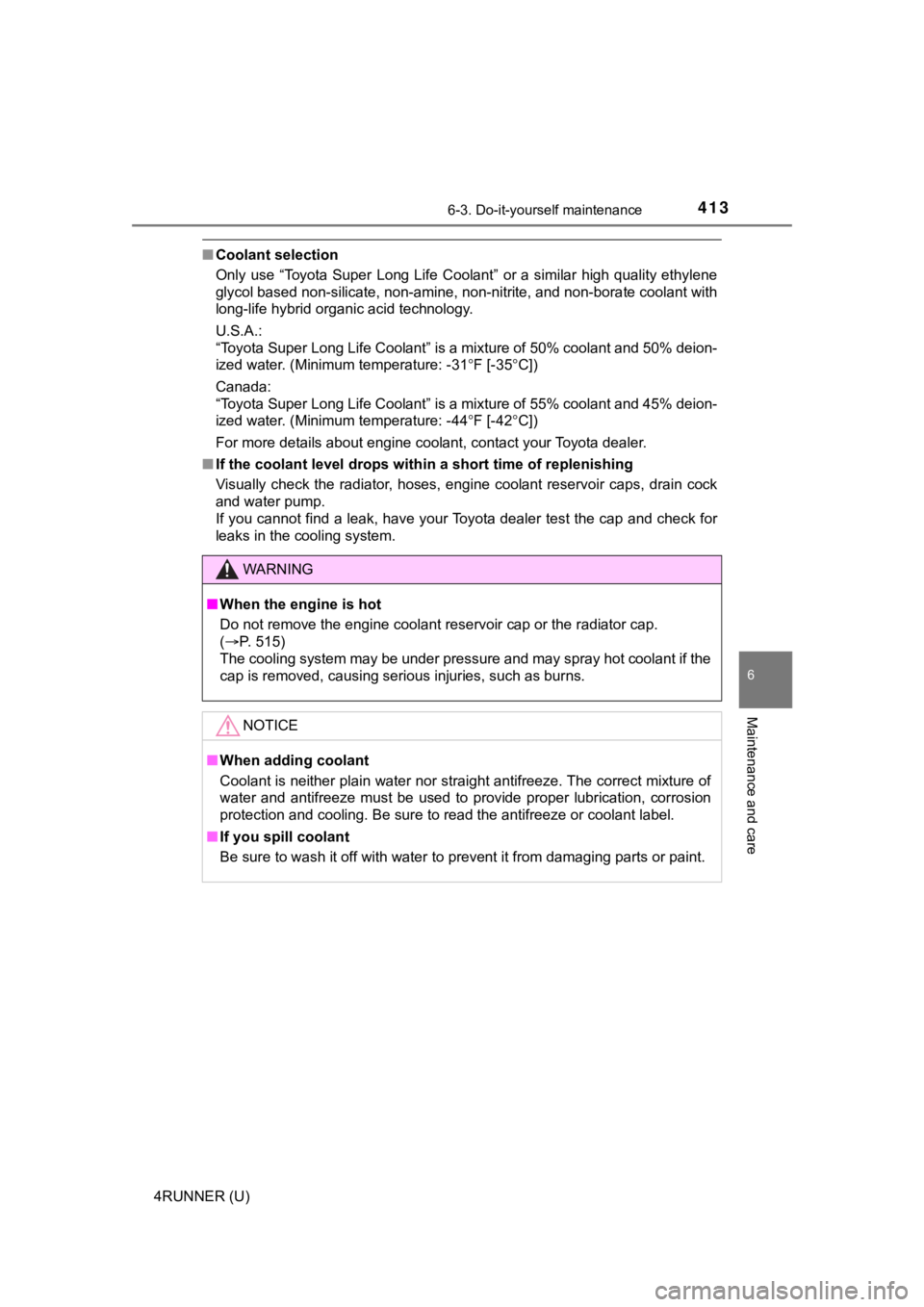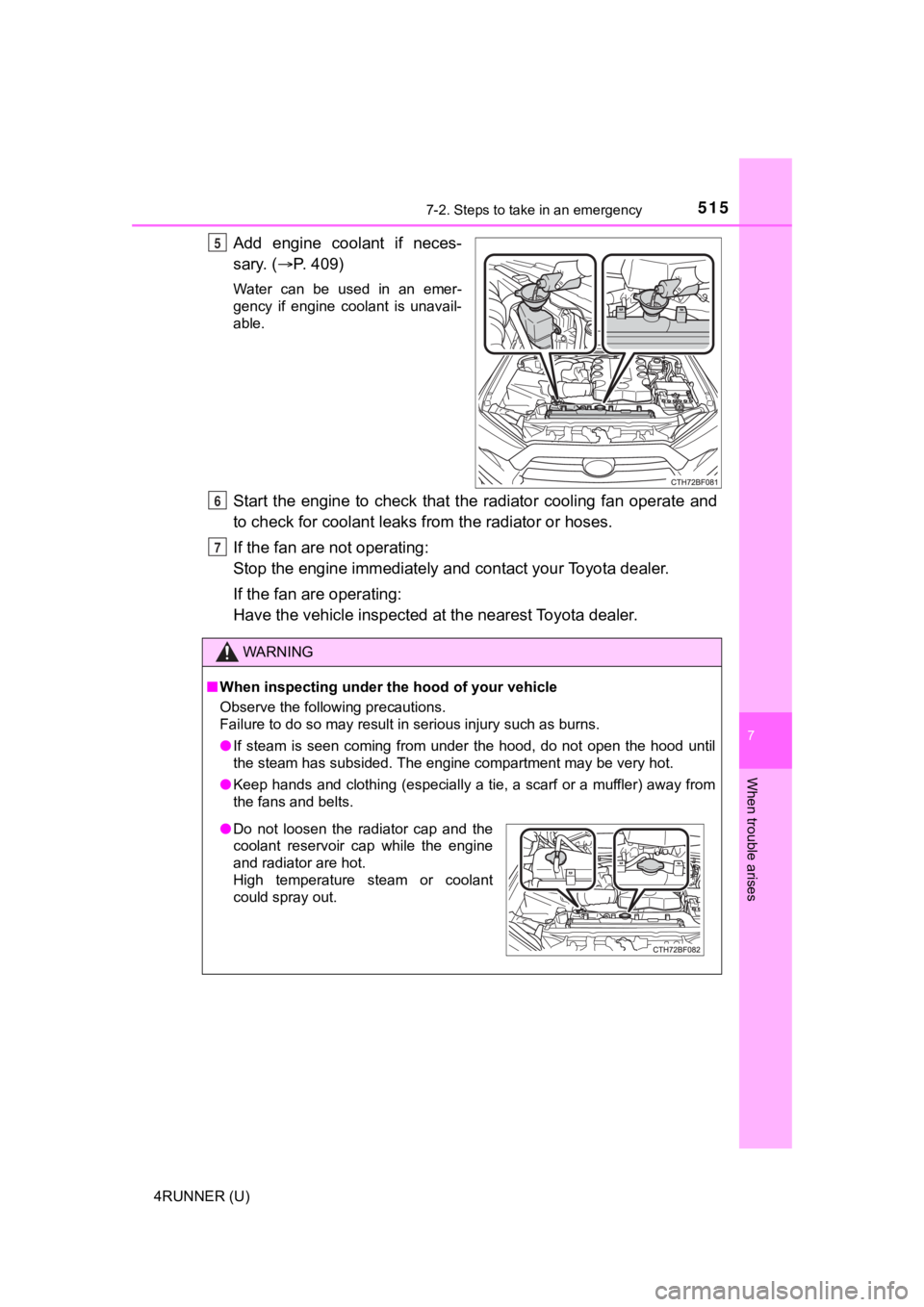Page 400 of 592
4006-2. Maintenance
4RUNNER (U)
General maintenance
Listed below are the general maintenance items that should be
performed at the intervals specified in the “Owner’s Warranty
Information Booklet” or “Own er’s Manual Supplement/Sched-
uled Maintenance Guide”. It is recommended that any problem
you notice should be brought to the attention of your Toyota
dealer or qualified s ervice shop for advice.
Engine compartment
ItemsCheck points
BatteryCheck the connections. (P. 417)
Brake fluidIs the brake fluid at the correct level? ( P. 414)
Engine coolantIs the engine coolant at the correct level? ( P. 412)
Engine oilIs the engine oil at the correct level? (P. 410)
Exhaust systemThere should not be any fumes or strange sounds.
Power steering fluidIs the power steering fluid at the correct level?
(P. 416)
Radiator/condenserThe radiator and condenser should be free from
foreign objects. ( P. 414)
Washer fluidIs there sufficient washer fluid? (P. 420)
Page 405 of 592
4056-3. Do-it-yourself maintenance
6
Maintenance and care
4RUNNER (U)
Fuses (P. 446)• Fuse with same amperage rating as original
Light bulbs (P. 449)
• Bulb with same number and wattage rating as
original
• Phillips-head screwdriver
• Flathead screwdriver• Wrench
Power steering fluid
level ( P. 416)• Automatic transmission fluid DEXRON® II or III
• Rag or paper towel• Clean funnel
Radiator and con-
denser (P. 414)
Tire inflation pressure
( P. 4 3 6 )• Tire pressure gauge
• Compressed air source
Washer fluid
(P. 420)
• Water or washer fluid containing antifreeze (for
winter use)
• Funnel (used only for adding water or washerfluid)
ItemsParts and tools
Page 406 of 592

4066-3. Do-it-yourself maintenance
4RUNNER (U)
WARNING
The engine compartment contains many mechanisms and fluids that may
move suddenly, become hot, or become electrically energized. To avoid death
or serious injury, observe the following precautions.
■When working on the engine compartment
● Keep hands, clothing and tools away from the moving fan and eng ine
drive belt.
● Be careful not to touch the engine, radiator, exhaust manifold, etc. right
after driving as they may be hot. Oil and other fluids may also be hot.
● Do not leave anything that may burn easily, such as paper and r ags, in the
engine compartment.
● Do not smoke, cause sparks or expose an open flame to fuel or t he bat-
tery. Fuel and battery fumes are flammable.
● Be extremely cautious when working on the battery. It contains poisonous
and corrosive sulfuric acid.
■ Safety glasses
Wear safety glasses to prevent flying or falling material, fluid spray, etc.
from getting in your eyes.
NOTICE
■If you remove the air cleaner filter
Driving with the air cleaner filter removed may cause excessive engine wear
due to dirt in the air.
Page 408 of 592
4086-3. Do-it-yourself maintenance
4RUNNER (U)
Engine compartment
Washer fluid tank (P. 420)
Power steering fluid reservoir ( P. 416)
Engine oil level dipstick ( P. 410)
Engine coolant reservoir ( P. 412)
Engine oil filler cap ( P. 4 11 ) Brake fluid reservoir
( P. 414)
Fuse box ( P. 446)
Battery ( P. 417)
Condenser ( P. 414)
Radiator ( P. 414)1
2
3
4
5
6
7
8
9
10
Page 413 of 592

4136-3. Do-it-yourself maintenance
6
Maintenance and care
4RUNNER (U)
■Coolant selection
Only use “Toyota Super Long Life Coolant” or a similar high quality ethylene
glycol based non-silicate, non-amine, non-nitrite, and non-bora te coolant with
long-life hybrid organic acid technology.
U.S.A.:
“Toyota Super Long Life Coolant” is a mixture of 50% coolant and 50% deion-
ized water. (Minimum temperature: -31 F [-35 C])
Canada:
“Toyota Super Long Life Coolant” is a mixture of 55% coolant and 45% deion-
ized water. (Minimum temperature: -44 F [-42 C])
For more details about engine coolant, contact your Toyota deal er.
■ If the coolant level drops within a short time of replenishing
Visually check the radiator, hoses, engine coolant reservoir ca ps, drain cock
and water pump.
If you cannot find a leak, have your Toyota dealer test the cap and check for
leaks in the cooling system.
WARNING
■ When the engine is hot
Do not remove the engine coolant reservoir cap or the radiator cap.
(P. 515)
The cooling system may be under pressure and may spray hot coolant if the
cap is removed, causing serious injuries, such as burns.
NOTICE
■ When adding coolant
Coolant is neither plain water nor straight antifreeze. The cor rect mixture of
water and antifreeze must be used to provide proper lubrication , corrosion
protection and cooling. Be sure to read the antifreeze or coolant label.
■ If you spill coolant
Be sure to wash it off with water to prevent it from damaging p arts or paint.
Page 414 of 592
4146-3. Do-it-yourself maintenance
4RUNNER (U)
Check the radiator and condenser and clear away any foreign objects.
If either of the above parts is extremely dirty or you are not sure of
their condition, have your vehic le inspected by your Toyota dea ler.
■Checking fluid level
The brake fluid level should be
between the “MAX” and “MIN”
lines on the tank.
“MAX” line
“MIN” line
■Adding fluid
Make sure to check the fluid ty pe and prepare the necessary ite m.
■Refilling brake fluid
Turn the engine switch off.
Depress the brake pedal more than 40 times.
Remove the reservoir cap by hand. Add brake fluid up to the
“MAX” line.
If you do not follow the procedure above, the reservoir may over-
flow.
Radiator and condenser
WARNING
■ When the engine is hot
Do not touch the radiator or condenser as they may be hot and c ause seri-
ous injuries, such as burns.
Brake fluid
1
2
Fluid type FMVSS No.116 DOT 3 or SAE J1703 brake fluid
Items Clean funnel
1
2
3
Page 514 of 592
5147-2. Steps to take in an emergency
4RUNNER (U)
●The needle of the engine coolant temperature gauge ( P. 8 8 )
enters the red zone o r a loss of engine power is experienced.
(For example, the vehicle speed does not increase.)
● Steam comes out f rom under the hood.
Stop the vehicle in a safe place and turn off the air condition ing sys-
tem, and then stop the engine.
If you see steam:
Carefully lift the hood after the steam subsides.
If you do not see steam:
Carefully lift the hood.
After the engine has cooled
down sufficiently, inspect the
hoses and radiator core (radia-
tor) for any leaks. Radiator
Cooling fan
If a large amount of coolant leaks,
immediately contact your Toyota
dealer.
The coolant level is satisfactory
if it is between the “F” and “L”
lines on the reservoir.Reservoir
“F” line
“L” line
Radiator cap
If your vehicle overheats
The following may indicate that your vehicle is overheating:
Correction procedures
1
2
3
1
2
4
1
2
3
4
Page 515 of 592

5157-2. Steps to take in an emergency
7
When trouble arises
4RUNNER (U)
Add engine coolant if neces-
sary. (P. 409)
Water can be used in an emer-
gency if engine coolant is unavail-
able.
Start the engine to check that the radiator cooling fan operate and
to check for coolant leaks from the radiator or hoses.
If the fan are not operating:
Stop the engine immediately and contact your Toyota dealer.
If the fan are operating:
Have the vehicle ins pected at the nearest Toyota dealer.
5
WARNING
■When inspecting under th e hood of your vehicle
Observe the following precautions.
Failure to do so may result in serious injury such as burns.
● If steam is seen coming from under the hood, do not open the ho od until
the steam has subsided. The engine compartment may be very hot.
● Keep hands and clothing (especially a tie, a scarf or a muffler ) away from
the fans and belts.
6
7
● Do not loosen the radiator cap and the
coolant reservoir cap while the engine
and radiator are hot.
High temperature steam or coolant
could spray out.